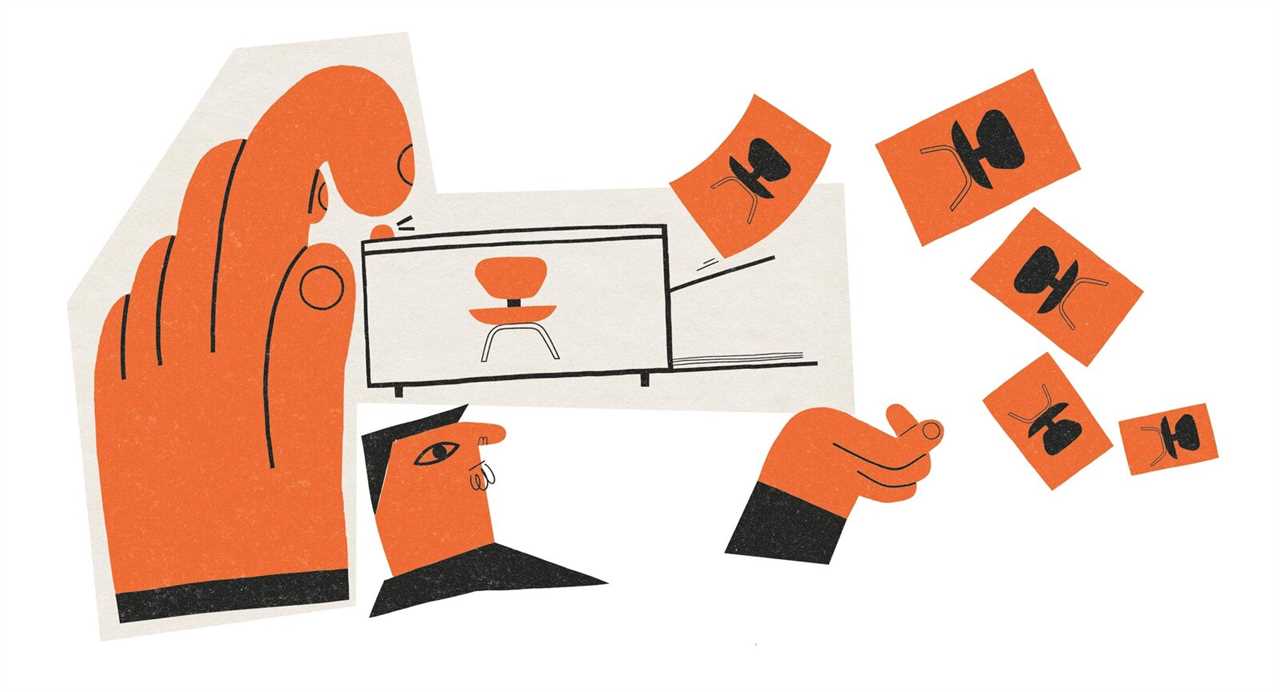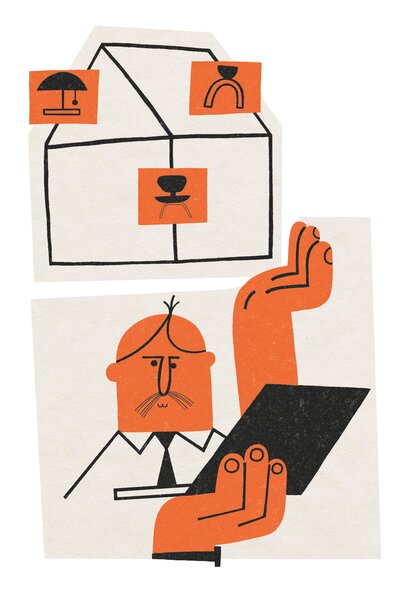Direct-to-consumer revolutionized the furniture market. What’s at stake when fakes are easier to find than ever?

If you type the words "togo sofa" into Google, chances are slim that your first result will be a link to an original Michel Ducaroy design sold by Ligne Roset. Instead, you may be directed to Wayfair, which sells a look-alike "Suede Armless Beanbag Chair" for around $700, about $3,000 less than the original’s price tag; an e-tailer hawking a "Ducaroy Portside 2 Seater Sofa" for around $1,900; or even an article from a reputable news outlet with the headline "The 11 Best Togo Sofa Replicas and Alternatives." Do the same for the iconic Emeco Navy chair, a Herman Miller Eames lounger, or dozens of other classic designs and you’ll be greeted with similar results.
"Copycats are everywhere," says John Edelman, president and CEO of furniture retailer Heller and former CEO of Design Within Reach. "They’re mainstream. They’re in major retailers, in malls across America, in freestanding stores."
They’re also all over social media platforms like TikTok, where the term "furniture dupes" has more than 5 billion views and which highlights videos that advise shoppers on where to find cheaper versions of mass-market items like Pottery Barn dressers and West Elm nightstands, as well as more design-forward wares like Eny Lee Parker lighting and Saarinen Tulip tables.
Knockoffs are certainly not a new phenomenon (Herman Miller launched a "Beware of Imitations" campaign as early as 1957). But as the furniture industry has been revolutionized by the onset of direct-to-consumer (DTC) brands that pull design elements from legendary pieces, as well as by an increasing number of e-commerce sites shipping from anonymous overseas manufacturers and by the influence of social media, the replica furniture market is booming now more than ever—which has designers on edge.
"Through the pandemic, we’ve seen a lot more copycats because it’s so easy through the internet to set up a new site and even sometimes steal pictures from us," says Simone Vingerhoets-Ziesmann, executive vice president of Ligne Roset for North and South America and a founding board member of the advocacy group Be Original Americas, which aims to educate consumers and design professionals on the dangers of copycat furniture.
There’s also been a well-documented demand for designer-looking home goods since the massive increase in people working, and just being, at home for the past two-plus years, showing their previously private rooms on Zoom or social media, says Anna Dawson, who recently graduated from the MFA furniture design program at Rhode Island School of Design and creates home goods in New York. "There’s very much an Instagram aesthetic of people’s homes that includes a lot of knockoffs," she says. "People want to seem in-the-know and cultured in that way."
And they also want these things fast and cheap, so they can be interchanged based on trends. Both of these requirements can easily be met for certain shoppers, thanks to discount e-commerce sites like Amazon and Wayfair, which offer thousands of designer dupes made overseas from materials like particle board, and DTC furniture brands that cut down costs by ditching brick-and-mortar showrooms and design their own pieces with an eye toward trendy styles and popular midcentury-modern aesthetics. But few furniture sellers we reached out to seemed eager to discuss the state of replicas or knockoffs for this article: Amazon declined to comment, and Wayfair did not return a request for comment, as was the case with several other popular DTC companies; a representative from one said that the company was "not interested in being included in a ‘knockoff’ story."

Illustration by Miguel Monkc
"There’s a lot of mimicry in design," says Andrea Rathborne, creative director of product design at Article, a Canadian direct-to-consumer furniture company that designs pieces with a midcentury-modern bent. "But we never want to mimic entirely, because that’s where you’re seeing an exact replica." She says her company’s designs come not only from aesthetics but also from customer feedback. "Data points we receive from our customers inspire our products."
All of the changing economics of furniture manufacturing and design have made the state of copycatting in the United States more complicated and contentious than ever. For legacy designers intent on stamping out copies of their work, "it’s like a game of Whac-A-Mole," says John Christakos, cofounder and CEO of Blu Dot, a home furnishings design company based in Minneapolis. "We set money aside every year into a fund I jokingly call ‘sport litigation’ so we can defend our designs." But often there is limited legal recourse at designers’ disposal.
Defense against furniture copycats is less black-and-white than, say, a case against literary plagiarism or the pirating of movies or music, because in the U.S., furniture designs, especially those from the midcentury period, are often covered by patents, which expire after 15 years, instead of trademarks, which can last forever. (In Europe, on the other hand, furniture designs are treated like art, with strict intellectual property laws that prohibit the creation of knockoffs.)
"For every product you make that’s worth copying, you make five misses. You have to have the ability to fail in order to succeed."
Designers can send cease-and-desist letters to manufacturers—though it’s sometimes tricky to find out who makes the dupes from overseas. Christakos says letters from CEOs to manufacturers do the trick about "60 to 70 percent of the time." (After seeing copycats of two Blu Dot lamps, he bought them so he could find identifying information about the manufacturer.) But if they don’t, designers with deep pockets can file lawsuits, though that’s where things get murky.
"If a company is using a registered name of a design, like passing off an Eames Lounge chair as a ‘Herman Miller Eames Lounge chair,’ then they’re definitely going to find themselves in litigation," says American University law professor Christine Farley, who is the faculty director for the school’s Program on Information Justice and Intellectual Property. But if a piece of furniture is protected under a patent with an expiration date and that patent expires, the furniture item then enters the public domain, where there is often no legal recourse unless the designers apply for and get approved for a trademark. (This is why you see so many Eames lounger replicas online.)
Newer designers are often advised to trademark their creations as best they can to avoid copycats, but now, more than ever before, well-established houses are trying to backtrack and trademark designs that were never protected after those 15-year patents expired. For example, earlier this year Herman Miller attempted to trademark the Eames Molded Plywood chair, but the company was denied by the U.S. Patent and Trademark Office. "They found that the design was functional and therefore could not be protected as a trademark," says Farley. "That’s a devastating defeat for Herman Miller because now there’s a public document saying they don’t have a trademark over that design," she says. "What was useful in the ’50s is not applicable anymore, legally."
Even though that classic chair did not get that trademark, the company was able to win suits involving trade dress functionality for another Eames chair last year. "Eighty-year-old designs are at the height of their strength in terms of legal protection," says Farley. "It’s an odd situation for intellectual property law, which is about new creativity and innovation."
To many current furniture makers, fighting copycats is not only a necessary part of the job but an industry-wide goal to sustain future designers, despite the time and money it takes to resolve these legal battles. In 2012, a slew of designers banded together to launch the aforementioned Be Original Americas in order to educate consumers about buying originals. They even partnered with U.S. Customs and Border Protection (CBP) to help officers learn how to spot counterfeits of the most iconic trademarked pieces of furniture that are imported from manufacturers. In 2019, CBP reported that it had seized approximately $30 million worth of counterfeit furniture, which came out to almost 18,000 items. (In context, in 2020, the U.S. furniture market was valued at just under $250 million.)
"Copycats slowly kill the future of design, meaning that if you can’t afford to get paid for what you designed, you can’t afford to design the next piece," says Edelman. "For every product you make that’s worth copying, you make five misses. You have to have the ability to fail in order to succeed."
In a practical sense, that means that when a designer spends years and dollars perfecting a piece of furniture—its measurements, fabric choice, and silhouette—it might cost much more than its replicated copy, which may have been created using online renderings or even by purchasing a product and re-creating it from lesser materials. But when you buy a knockoff at a price so dissimilar from the original (like a $700 sofa that looks just like a Togo sofa but isn’t one), you’re losing out not only on quality, longevity, and craftsmanship, but possibly also on support for a working artist.
"Heller does not sell a plastic chair," says Edelman. "We sell a chair designed by Mario Bellini, one of the greatest chair designers who’s ever lived. We talk about the romance behind it. That’s what it’s about."
Designers also worry that copycats can stymie creativity. "If [a design] is not protected, it might lessen the incentive to make it in the first place," says Christakos.
"The danger is that people will throw their arms up in anger and say, ‘Why bother? If I spend all this time making something and bringing it to life and in an instant someone can steal it and reap the rewards, why do it in the first place?’"
"There are a whole bunch of people who really just want to furnish their place with something that looks good."
Plus, there’s the sustainability element: A well-cared-for designer sofa may last decades. Before purchasing it you can often learn about its carbon footprint and the materials that make it more environmentally responsible. When you tire of it, there will also likely be a healthy resale market available on Facebook Marketplace, Etsy, or eBay. Fast-furniture replicas may wear out sooner or "end up in a landfill, where they will likely rot," says Vingerhoets-Ziesmann (though there may also be resale potential for these items, too). Still, between 2005 and 2018, furniture waste grew by 30 percent as the rise of fast furniture took hold.
And, yet, there is an argument that perhaps replicas are not only a well-established part of the marketplace, but actually good for the design industry, innovation, and the economy.
"Furniture is a space where intellectual property rights don’t drive innovation or limit competition as they might in some other areas," says NYU law professor Christopher Sprigman, who studies intellectual property and cowrote The Knockoff Economy: How Imitation Sparks Innovation. "I consider [time-limited patents] to be a great outcome that gets designs out to the masses."
He suggests that after a design enters the public domain, other manufacturers can innovate on that design by playing with fabrics, measurements, and materials as well as with shipping and manufacturing strategies to make their wares stand out in a competitive market. "Competition is incentivizing innovation every day, probably more profoundly than intellectual properties," says Sprigman.
While some companies may market their products on the beauty and whimsicality of a designer’s history or a specific ethos as well as on the quality of their goods, many consumers don’t look at chairs and identify them right away as specific designs or attached to a certain designer, says Sprigman. "They see a chair," he says. "That’s what furniture is. It’s industrial design."
And while designers argue that replica furniture takes away from their own business, Farley suggests that isn’t always true. Instead, for all sorts of reasons, someone who buys a replica may not be the kind of person who would buy an original. "I might say, ‘I want something that looks like a Nelson slat bench to put stuff on my patio, but I don’t want it to be of good quality. I want it right now for this purpose.’ That’s not a lost sale," she says, because that buyer would likely not be in the market for an original Nelson bench that retails for almost $2,000. They just want something that functions well, isn’t an eyesore, and won’t require months or years of saving and planning.

Illustration by Miguel Monkc
Because, of course, this is the main reason that people buy replicas: They’re cheaper.
"There are a whole bunch of people who really just want to furnish their place with something that looks good," says Sprigman. "They don’t care if it’s an approved design. They care if it looks right in their room."
A lot of that ethos drives direct-to-consumer companies like Article and Sundays, another Canadian furniture company, which was founded in 2019. When asked how Sundays comes up with new designs, Noah Morse, its cofounder and director of product design and development, wrote in an email that his team constantly requests feedback from customers and asks questions like "What is on the market that is similar, and how will this new idea improve that market?" That research may lead to a variation on a classic that embraces a new fabric trend, but it assumes much less risk than a traditional brand backing a designer’s untested vision through a long product-development process.
When coming up with a "new idea," Morse says, his team "conducts a comprehensive comparative analysis during product development" to ensure it’s not accidentally copying an existing design. "No designer can lay claim to a certain timeless form as their design."
But the ubiquity of certain elements does force designers to expand their craft to ensure they’re not making a major faux pas by duplicating something that already exists (and being featured on an Instagram account like Design Within Copy, which highlights wares that hew too closely to others and calls out obvious knockoffs). "Sometimes it feels like everything’s already been designed," says Dawson. "You have to be even more innovative, not just in materials but also details. That’s how your work stands out."
At Article, Rathborne says she and her designers zero in on the details that make their designs unique from what’s already out there—fabric choice, stitching, construction, sizing—and go through rigorous critiques to ensure they’re not copying other designs. And while DTC brands have been called out for emulating classic designs, some of Article’s most popular items, like the Sven sofa, which starts at $1,400, have been replicated as well. (Google searches for "article sven dupe" top 300,000.)
Consumers on a budget who wish to avoid knockoffs altogether have solutions: Buy originals secondhand, support designers who offer items in your budget, or purchase lesser-known designs from iconic brands at lower prices.
But there’s still a gray area for buyers who want real-deal items and may not be super savvy when it comes to avoiding fakes. Sure, there are tried and true ways to know you’re getting the goods, like buying from trusted retailers and checking for signature design elements, but many online outlets and furniture suppliers don’t specify when an item is a replica and will sell it as if it were the real one. Vingerhoets-Ziesmann says Ligne Roset often fields calls from disappointed customers who discovered they had been sold fakes after making the purchase.
"The worst crime is misleading consumers," says Edelman. "But, then again, when you buy a Rolex on Canal Street, you know it’s not real."
—
Head back to the November/December 2022 issue homepage
Read More
By: Jessica Goodman
Title: How E-Commerce Changed the Knock-Off Furniture Game
Sourced From: www.dwell.com/article/state-of-knock-off-furniture-e-commerce-direct-to-consumer-23d2e44f
Published Date: Sat, 05 Nov 2022 19:12:22 GMT
Did you miss our previous article...
https://trendinginbusiness.business/real-estate/this-floridian-designer-overcame-neighborhood-restrictions-for-a-lawnlike-look
.png)





